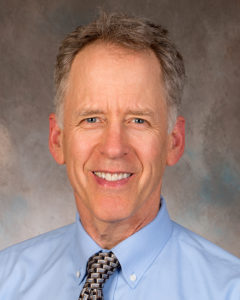- ACE and SEE Live: An Interactive Patient Safety Session
- 1:15-2:15 p.m. Tuesday
- West, Room 3001
If you need to turn your attention from education sessions to safety CME credits, a new, fast-paced, interactive panel can meet your needs.
“We will probably cover two dozen questions in an hour from both the ACE (Anesthesia Continuing Education) publication and SEE (Self-Education and Evaluation) publications,” said Joel O. Johnson, M.D. Ph.D., Professor of Anesthesiology at the University of Wisconsin School of Medicine and Public Health. “We want to keep things moving at a rapid-fire pace. The intent is to make this something you can learn from and get your adrenaline up a bit by seeing if you answer all the questions correctly. Anesthesiologists are nothing if not competitive!”

Joel O. Johnson, M.D., Ph.D. moderates a new, fast-paced interactive panel.
Dr. Johnson will moderate Tuesday’s session, “ACE and SEE Live: An Interactive Patient Safety Session.” He will be assisted by editors from each of the ASA safety publications.
ACE is providing three editors: Stacy L. Jones, M.D., Assistant Professor of Anesthesia at the University of Arkansas for Medical Sciences, Little Rock; Bhargavi Gali, M.D., Consultant in Anesthesiology and Perioperative Medicine at the Mayo Clinic Rochester; and Christopher J. Lace, M.D., Assistant Professor of Anesthesiology at the University of Colorado School of Medicine, Denver.
SEE editors include: Norma J. Klein, M.D., Professor of Pediatric Anesthesiology, UC Davis School of Medicine; Wade A. Weigel, M.D., FASA, Professor of Anesthesia at Virginia Mason Medical Center in Seattle; and Robert L. Hsiung, M.D., anesthesiologist at Virginia Mason Medical Center.
The publications provide two different perspectives on patient safety, Dr. Johnson said. ACE challenges readers to assess their own base knowledge of anesthesia, the standard that every anesthesiologist should be able to use and apply regardless of their practice type or location. The ACE publication acts as a review journal to help anesthesiologists stay current with core topics.
SEE is more like a journal club, focusing on the newest and most important publications in anesthesia.
The session will spotlight different approaches to patient safety in the questions from the two sets of journal editors. On the ACE side, look for questions about characteristics most commonly associated with postoperative myalgia in patients who have been given succinylcholine. On the SEE side, expect questions pulled from journal articles in the last year or so, such as the specific reversing agent most commonly used for a recently approved muscle relaxant.
“This is no place to sit and soak up information,” Dr. Johnson said. “Every participant should be ready with their phones to respond to every multiple-choice question. A live graph shows the changing audience responses so you can see where you lie in relationship to the rest of the audience. And the editor who posed the question will explain in concise detail why only one answer is correct and why the other three are wrong.”
Learning and competition aside, this session is a convenient and enjoyable way to add safety CME credits. Every anesthesiologist must meet national safety CME requirements as part of the maintenance of certification process, and many states have their own requirements.
Return to Archive Index